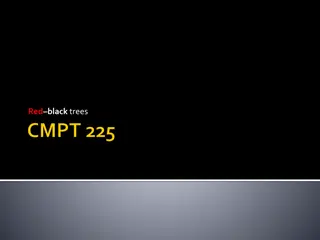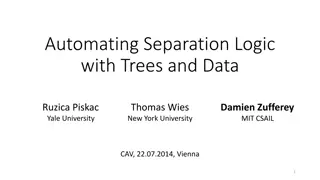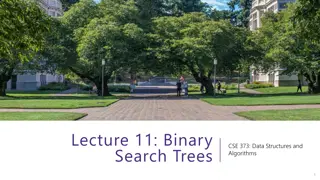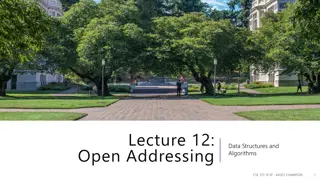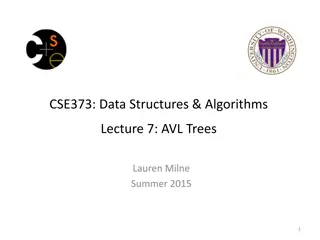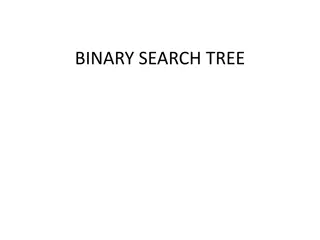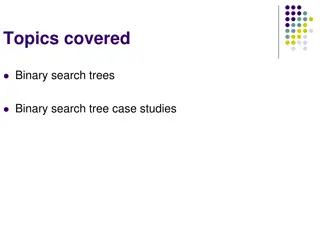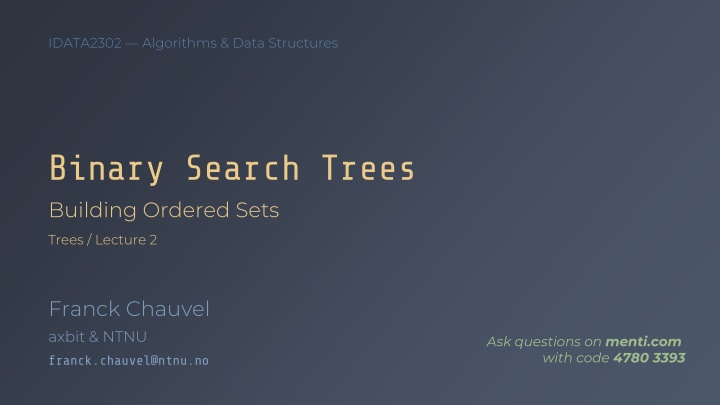
Ordered Sets and Binary Search Trees: Building Data Structures for Efficient Searching
Learn about building ordered sets and binary search trees in algorithms and data structures. Understand the operations such as search, insertion, deletion, and more to efficiently manage ordered collections. Explore the concept of tree structures for organizing data elements and optimizing search efficiency.
Download Presentation

Please find below an Image/Link to download the presentation.
The content on the website is provided AS IS for your information and personal use only. It may not be sold, licensed, or shared on other websites without obtaining consent from the author. If you encounter any issues during the download, it is possible that the publisher has removed the file from their server.
You are allowed to download the files provided on this website for personal or commercial use, subject to the condition that they are used lawfully. All files are the property of their respective owners.
The content on the website is provided AS IS for your information and personal use only. It may not be sold, licensed, or shared on other websites without obtaining consent from the author.
E N D
Presentation Transcript
IDATA2302 Algorithms & Data Structures Binary Search Trees Building Ordered Sets Trees / Lecture 2 Franck Chauvel axbit & NTNU Ask questions on menti.com with code 4780 3393 franck.chauvel@ntnu.no
Sets Without HashTable? Hash table? Set ADT get(key): value put(key, value) Tree Binary search Sort by key Maintain order O(1) No order O(log n)
Agenda 1. The Ordered Set ADT 2. Binary Search Trees 1. Search 2. Minimum and Maximum 3. Predecessor and Successor 4. Insertion 5. Deletion 3
Ordered Set ADT search(key): Test the existence of a given key insert(key) Add a new key in the set, or raise an error if a duplicate is found delete(key) Remove the given key from the set minimum() find the smallest key maximum() find the largest key predecessor(key) find the key that immediately precedes the given one successor(key) find the key that immediately follows the given one 4
The Idea Binary Search Trees X all the elements smaller than X all the elements greater than X left right subtree subtree 6
Example 23 71 54 8 61 23 17 67 71 81 64 36 36 11 64 89 89 54 99 36 39 39 8 17 61 81 67 99 39 11 44 38 38 38 44 44 23 36 54 7
Does that look familiar? Where did we see a tree like that? 8
Yes! The Binary Search! Find 67 54 < 67 86 > 67 27 < 67 Found 0 1 2 3 4 5 6 7 8 9 10 11 8 11 23 27 35 37 39 54 55 67 86 213 3rd pick 2nd pick 1st pick smaller larger
Runtime Efficiency of the Binary Search 1st split Log2 n 2nd split 2nd split 3rd 3rd 3rd 3rd 0 1 2 3 4 5 6 7 8 9 10 11 8 11 23 27 35 37 39 54 55 67 86 213 smaller larger
search(key) Finding a key in the tree 11
Tree Search Where is 38? Found It! root node not 54! but 38 < 54 54 54 not 23! but 38 > 23 23 23 71 11 36 36 not 36! but 38 > 36 64 89 not 39! but 38 < 39 39 39 8 17 61 81 67 99 Found it! 38 38 44 12
Tree Search Could not find 27! root node not 54! but 27 < 54 54 54 not 23! but 27 > 23 23 23 71 11 36 36 not 36! but 27< 36 64 89 39 8 17 61 81 67 99 Not Found! 38 44 13
The Code Tree Search public Item search(Item givenItem) throws NoSuchElement { int difference = this.item.compareTo(givenItem); if (difference > 0) { if (this.hasLeftChild()) { return this.left.search(givenItem); } throw new NoSuchElement(); } else if (difference < 0) { if (this.hasRightChild()) { return this.right.search(givenItem); } throw new NoSuchElement(); } else { return this.item; } } 14
Minimum & Maximum Find the smallest and largest keys 15
Minimum and Maximum Tree Search root node 54 54 23 23 71 11 11 36 64 89 39 8 8 17 61 81 67 99 38 44 16
The Code Minimum & Maximum public Item minimum() { if (this.hasLeftChild()) { return this.left.minimum(); } return this.item; } public Item maximum() { if (this.hasRightChild()) { return this.right.maximum(); } return this.item; } 17
Predecessor & Successor Find preceding and following keys 18
Case 1: Target with Children Finding the Successor root node 54 54 not 54! but 36 < 54 23 23 not 23! but 23 < 36 71 Found! 36 36 11 64 89 target 39 39 8 17 61 81 67 99 38 38 44 minimum of left subtree 19
Case 2: No Child Finding the Successor root node 54 54 not 54! but 44 < 54 not 23! but 23 < 44 23 23 71 11 36 36 not 36! but 36 < 44 64 89 not 39! but 39 < 44 39 39 8 17 61 81 67 99 38 44 44 target success of the minimum is the parent 20
The Code Predecessor & Successor public Item successor(Item givenItem) throws NoSuchElement, NoSuccessor { int difference = this.item.compareTo(givenItem); if (difference < 0) { if (hasRightChild()) { return right.successor(givenItem); } throw new NoSuchElement(); } else if (difference > 0) { if (hasLeftChild()) { try { return left.successor(givenItem); } catch (NoSuccessor error) { return this.item; } } throw new NoSuchElement(); } else { if (hasRightChild()) { return right.minimum(); } throw new NoSuccessor(); } } Case 2.b: Tried on the left subtree, but no successor found! Case 1: Found it! It has children Case 2.a: Found it! No child 21
insert(key) Adding a new key in the set 22
The Idea Insertion insert(19) 54 54 17 < 54 17 < 23 23 23 71 11 < 17 11 11 36 64 89 39 What next? 8 17 17 61 81 67 99 17 < 19 38 44 19 23
if (hasLeftChild()) { The Code Insertion this.left.insert(givenItem); } else { this.left = new Tree(givenItem); public Tree<Item> insert(Item givenItem) { } int difference = this.item.compareTo(givenItem); return this; if (difference > 0) { // Left Case } else if (difference < 0) { // Right Case if (hasRightChild()) { } else { this.right.insert(givenItem); throw new RuntimeException( } else { "Duplicated item " + item); this.right = new Tree(givenItem); } } } return this; 24
delete(key) The trickier part 25
Case 1: Node Without Child Deletion delete(17) 54 54 17 < 54 17 < 23 23 23 71 11 < 17 11 11 36 64 89 39 8 17 17 61 81 67 Found! 99 38 44 Recursively: we rebuild subtrees 26
Case 1: Node Without Child Deletion Code public Tree<Item> delete(Item givenItem) throws NoSuchElement { int difference = this.item.compareTo(givenItem); if (difference < 0) { if (hasRightChild()) { this.right = this.right.delete(givenItem); return this; } throw new NoSuchElement(); } else if (difference > 0) { if (hasLeftChild()) { this.left = this.left.delete(givenItem); return this; } throw new NoSuchElement(); } else { } } return null; 27
Case 2: Node With 1 Child Deletion delete(36) 54 54 17 < 54 23 < 36 23 23 71 36 36 11 64 89 Found! 39 8 17 61 81 67 99 38 44 28
Case 2: Node With 1 Child Deletion Code public Tree<Item> delete(Item givenItem) throws NoSuchElement { int difference = this.item.compareTo(givenItem); if (difference < 0) { if (hasRightChild()) { this.right = this.right.delete(givenItem); return this; } throw new NoSuchElement(); if (hasOnlyLeftChild()) { return this.left; } if (hasOnlyRightChild()) { return this.right; } return null; } else if (difference > 0) { if (hasLeftChild()) { this.left = this.left.delete(givenItem); return this; } throw new NoSuchElement(); } else { } } ; 29
Case 3: Node With 2 Children Deletion delete(54) 54 54 Found! 23 71 11 36 64 89 39 8 17 61 61 81 67 99 successor of 54 38 44 30
Case 3: Node With 2 Children Deletion Code if (hasLeftChild() && hasRightChild()) { try { Tree<Item> successor = this.findSuccessorTree(this.item); successor.right = this.right.delete(successor.item); successor.left = this.left; return successor; public Tree<Item> delete(Item givenItem) throws NoSuchElement { int difference = this.item.compareTo(givenItem); if (difference < 0) { if (hasRightChild()) { this.right = this.right.delete(givenItem); return this; } throw new NoSuchElement(); } catch (NoSuccessor error) { throw new RuntimeException(error); } } if (hasLeftChild()) { return this.left; } if (hasOnlyChild()) { return this.right; } return null; } else if (difference > 0) { if (hasLeftChild()) { this.left = this.left.delete(givenItem); return this; } throw new NoSuchElement(); } else { } } ; 31
Recap Recursive No duplicate allowed Runtime Average Operation Space Best Worst insert delete search (1) (log?) (?) (log?) (1) (log?) (?) (log?) (1) (log?) (?) (log?) maximum minimum predecessor successor (1) (log?) (?) (log?) (1) (log?) (?) (log?) (1) (log?) (?) (log?) (1) (log?) (?) (log?) 32
Thank You! Questions, Comments, or Ideas? Franck Chauvel Axbit & NTNU franck.chauvel@ntnu.no


